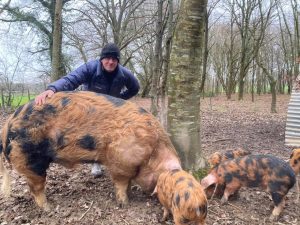
I have been invited to one or two farm visits and with good bio-security and the government guidelines of social distancing and wearing of masks it has been possible and it has again made me ask one or two questions…
When you are out on your rounds and tend to your pigs take a minute to observe them all, look at the shape, length, height and colouration and perhaps share your observations…
(Please note: This is NOT a fault anaylsis of the OSB Pig breed but an observation anaylsis, whereby i hope our good senses will of course adhere to our better judgement)
In general the evolution of British pigs have come a long way thanks to Robert Bakewell and not just the characteristics of the breeds but the formation of bloodlines, pedigrees and of course the structure and evolution of each of our British Pig Breeds which we have come to recognise today.
What about our breed, the Oxford Sandy and Black Pig, has it changed over the years? Are there noticeable changes, are these changes good or bad or are we just recognising the breed as the years go by and just taking the breed for granted. And that what we own, breed or being sold is just good enough because the breed is evolving and our observations are dictated to us by experience. But what if our experiences are limited. Should we be forever looking to embrace changes in the Oxford Sandy Black Pig breed and are these changes good?
We all look at our sows, boars, gilts and weaners everyday but because we own them we tend not to look at them with a critical eye and if we do look at them with a critical eye are we being too critical. So is beauty in the eye of the beholder?

The observations over the years have been:
- Colouration: 16 years ago OSB Pigs were particularly light in colour. In particular, the Clarence Pig Bloodline did suffer such a problem and this has improved over the years whereby we now see the Clarence bloodline a nice sandy colour. But do not be mistaken when you see older sows/boars lighter in colour, like us they do go lighter with age whereby some keep their colour and some go even darker with age.
- Markings: The breed is seeing black flecks instead of patches or blotches and in some cases not very many patches or blotches. REMEMBER THE “BLACK” DEFINES OUR BREED
- Length: Observation of the breed being long in length, sometimes too long giving problems when serving and seeing heavy dips in the back.
- Facial points: Long snouts are common place as is suppressed eyes leading to sight problems. Wrinkly eyes are also a trait being observed. This may be due to over weight or that the face is too dished.
- Feet: The actual feet have been recognised as being very lean whilst others very thick set. Noticeably on boars. Also an increase in nail growth.
- Litter sizes: We have seen an increase in litter sizes over the years. Whereby the average litter size would be eight. We are now seeing litter sizes of 16 and 18. This does fluctuate from year to year. With the largest size being mentioned by the late Andrew Sheppy coming from a Mr Brickell Chasewoods Princess who had Oxford Sandy Black Pig litter sizes of 20 and 22.
- We have seen through observations over the years from the Oxford Sandy and Black Pig Group Charity, that the overall Oxford Sandy Black pig live litter size has been considerably larger with the average common size being 12.
- Teat alignment: boars and sows with 16 teats are now developing within our breed with 14 being more common. When we would see 12 observed say some 14 to 16 years ago.
- Size – our pigs have been getting larger BUT these last two years my observations have seen small OSBs this is a breeding fault as the Oxford Sandy and Black Pig has recognition as an all purpose, versatile breed and if they become small we will loose its value as a good meat pig.
